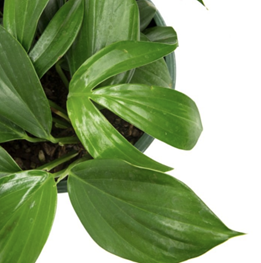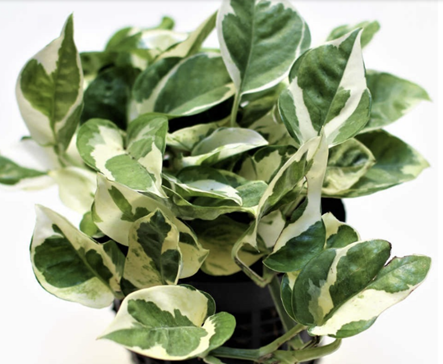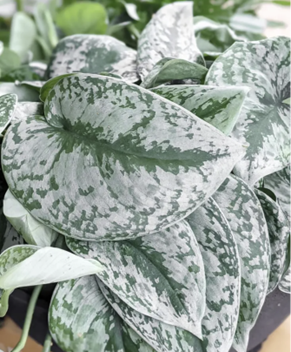Plant Spotlight: Pothos
Pothos, with its stunning cascading vines and effortless
maintenance, has become a popular choice for houseplant enthusiasts. As a
member of the Araceae family, there are several types of pothos, including
Epipremnum aureum, Epipremnum pinnatum, and Scindapsus pictus. These plants are
indigenous to the tropical regions of Southeast Asia and are distinguished by
their trailing vines and heart-shaped leaves. This blog post will provide you
with all the necessary details to cultivate and appreciate your Pothos plant.
Water
Pothos plants prefer soil that is consistently moist but not saturated. A good rule of thumb is to water your Pothos thoroughly when the top inch of soil feels dry to the touch. This ensures that the roots receive adequate hydration without risking waterlogging.
When it's time to water, give your Pothos a generous
watering session, allowing water to penetrate the soil deeply. This helps to
ensure that the entire root system receives moisture. However, pothos
plants dislike sitting in standing water, as it can lead to root rot and other
issues. To avoid this, make sure to allow excess water to drain away freely.
Light
Pothos
plants do well in a variety of lighting conditions, but they prefer bright,
indirect light. They can also tolerate low light, but their growth will be
slower. Direct sunlight can burn their leaves, so be sure to keep your Pothos
out of direct sunlight.
Fertilizer
Pothos
plants do not require a lot of fertilizer, but they do benefit from a regular
feeding during the growing season (spring and summer). Use a balanced,
water-soluble fertilizer once a month to keep your Pothos healthy and happy.
Humidity & Temperature
Pothos
plants do well in average household humidity and temperatures. They can
tolerate slightly lower temperatures, but they do not like to be exposed to
temperatures below 50°F (10°C). Avoid placing your Pothos near drafty windows
or doors.
Repotting
Pothos
plants do not need to be repotted often, but they can benefit from a larger pot
as they grow. Repot your Pothos when you see roots coming out of the bottom of
the pot, or when the plant becomes too top-heavy.
Propagating
Pothos
plants are easy to propagate from stem cuttings. Simply cut a stem with a few
leaves and place it in water or soil. In a few weeks, roots will start to form,
and you will have a new Pothos plant.
Pests
Pothos
plants are generally resistant to pests, but they can occasionally be affected
by mealybugs, spider mites, or scale insects. If you notice any pests on your
plant, use an insecticidal soap to treat the problem.
Varieties
There
are many different varieties of pothos, including:
- Argyraeus Pothos: Scindapsus pictus - This pothos variety has large, heart shaped dark green leaves with sparse silver markings, giving it a unique look. This compact variety has soft leaves and can be trained to climb along the edges of shelves.
- Albo-Variegata: Epipremnum Pinnatum – This variety has green leaves with white variegation, creating a striking contrast. The variegation is caused by a chimeric gene (some tissue can produce chlorophyll and others cannot, most common type of variegation).
-
Baltic Blue Pothos: Epipremnum
Pinnatum – This pothos variety has elongated leaves that resemble a
dragon’s tail and have a dark green color. is a unique Pothos variety
with heart-shaped leaves that showcase a beautiful blue-green coloration. The
leaves have a glossy texture and an iridescent quality, resembling the
shimmering depths of the Baltic Sea.
-
Cebu Blue Pothos: Epipremnum
Pinnatum – Cebu
Blue Pothos has elongated leaves that are a stunning blue-green color and have
a velvety texture. One of the standout features of Baltic Blue Pothos is its
silver variegation. The leaves are adorned with silver patches or streaks that
create a striking contrast against the blue-green backdrop. This silver
variegation gives the plant a lustrous, almost metallic appearance, adding an
element of visual interest and elegance. It is a slow-growing trailing plant
and is often used in hanging baskets.
-
Dragon Tail Pothos: Epipremnum
Pinnatum – This
variety features elongated leaves that resemble the shape of a dragon's tail,
hence the name. The leaves have distinctive ruffled edges, creating a unique
and textured appearance. The color of the leaves can vary from green to a
deeper shade of green, depending on the specific plant and growing conditions.
The foliage of Dragon Tail Pothos tends to have a glossier texture compared to
other Pothos varieties
-
Emerald Pothos: Epipremnum
Aureum – This variety has a dark green center with lighter bright
green outside, heart-shaped leaves that are glossy and lush. This is a variant of the
N’Joy pothos, and looks very similar to the Global Green Pothos, the difference
being the Emerald Pothos’ variegation typicaly melt together, rather than presenting
sharp transitions.
-
Glacier Pothos: Epipremnum
Aureum – The Glacier Pothos has white and green variegated heart-shaped
leaves that are small and dainty. The variegation patterns can vary from plant
to plant, but typically the leaves have marbled or speckled patterns of green
and white. The foliage has a glossy texture. It is a slow-growing plant that is
perfect for hanging baskets.
- Global Green Pothos: Epipremnum Aureum – A visually stunning plant with lush, vibrant green foliage. Its heart-shaped leaves are smooth and glossy, reflecting light to create a lustrous appearance. The plant showcases a uniform green color without any variegation, giving it a consistently fresh and vibrant look. With its trailing growth habit, the vines gracefully cascade down, adding a dynamic element to its visual appeal.
-
Golden Pothos: Epipremnum
Aureum –This is
the most common variety of pothos, that boasts heart-shaped leaves that exhibit
a stunning blend of green and yellow hues. The vibrant golden-yellow
variegation spreads across the glossy, deep green foliage, creating a striking
contrast and adding a touch of warmth and radiance to any space. The leaves
feature a smooth texture and a trailing growth habit, cascading gracefully down
from containers or climbing up supports.
- Jade Pothos: Epipremnum Aureum –This variety is visually captivating with its glossy, heart-shaped leaves that exhibit a stunning combination of deep green and vibrant jade hues. The foliage showcases a beautiful contrast between the rich green color and the lighter, almost translucent jade tones, adding a touch of elegance and natural beauty to any space.
-
Jessenia Pothos: Epipremnum
Aureum – The foliage features a combination of vibrant green and
creamy yellow colors, creating an eye-catching contrast. The variegation
patterns vary from plant to plant, with some displaying marbled patterns and
others showcasing distinct patches of yellow.
-
Manjula Pothos: Epipremnum
Aureum – With its
stunning variegated leaves, Manjula Pothos showcases a mesmerizing blend of
green, creamy white, and silver hues. The marbled patterns on the foliage
create an exquisite and elegant appearance. Each leaf carries a distinct and
intricate variegation, making every Manjula Pothos plant a work of art. Its
trailing vines gracefully cascade down containers or climb up supports, adding
a touch of enchantment to any space.
- Marble Queen Pothos: Epipremnum Aureum –The leaves of Marble Queen Pothos feature a marbled pattern of green and creamy white, creating a captivating contrast. The creamy white patches are irregularly spread across the leaves, giving them a marble-like appearance, hence the name. It is very similar to the snow queen pothos, has typically less white, with half and half green/white coloring.
-
N'Joy Pothos: Epipremnum
Aureum – The
leaves of N'Joy Pothos display a striking variegation pattern, featuring a
combination of lush green and creamy white colors. The variegation creates a
beautiful contrast and adds a touch of elegance to the plant. With its small heart-shaped
leaves and vibrant variegation, N'Joy Pothos effortlessly adds a pop of visual
interest and charm to any indoor space. This cultivar is favored by plant
enthusiasts for its distinctive appearance and its ability to thrive in various
light conditions.
-
Neon Pothos: Epipremnum
Aureum – The
leaves of the Neon Pothos showcase a vibrant lime-green color that instantly
grabs attention. The intensity of the neon green hue adds a pop of brightness
and liveliness to any space. This variety of Pothos retains the classic
heart-shaped leaf structure and features a trailing growth habit, allowing the
vines to elegantly cascade down from containers or climb up trellises.
-
Pearls and Jade Pothos: Epipremnum
Aureum –This
variety showcases heart-shaped leaves that are predominantly green with
splashes of creamy white and silvery-gray variegation. The variegation patterns
resemble pearls scattered across the surface of the leaves, giving the plant
its name.
- Silver Satin (Exotica) Pothos: Scindapsus pictus - The leaves of Exotica Pothos display striking variegation patterns that set them apart from other Pothos varieties. The foliage showcases a combination of green, yellow, and white colored heart-shaped leaves, creating a beautiful and intricate mosaic-like appearance. One of the notable features of Exotica Pothos is its mottled and marbled patterns on the leaves. The variegation is not uniform, with patches and streaks of different colors dispersed throughout the foliage. The leaves are thick and broad (almost as stiff as cardboard) and can be the size of your hand.
-
Silvery Ann Pothos: Scindapsus Pictus – Similar
to the Argyraeus variety, Scindapsus 'Silvery Ann' exhibits foliage with a
softer texture. The characteristic Scindapsus hook is present at the bottom tip
of its leaves, maintaining the usual asymmetrical shape. It has prominent
silver variegation, some leaves look like they were dipped in silver paint,
with a significant portion covered in shiny silver. The remaining portion of
the leaves is speckled with silver, creating a captivating contrast. In certain
instances, individual leaves may even appear completely silver, adding an extra
touch of allure to this remarkable plant.
-
Silver Splash: Scindapsus Pictus – Closely
resembling the Exotica, the Silver Splash variety showcases a distinctive
variegation pattern that is dappled instead of streaked, and the silver tones
are more subdued. However, the leaves retain the same impressive size,
thickness, and visual impact as those of the Exotica. What sets the Silver
Splash apart is its captivating silvery-blue appearance.
-
Shangri La Pothos: Epipremnum
Aureum – It features interesting, shriveled-looking leaves with a
beautiful blend of green and creamy yellow variegation. The unique leaves look
wrinkled and rolled up (sometimes it’s also called the spinach pothos) The
variegation forms marbled patterns, creating an eye-catching contrast.
-
Snow Queen Pothos: Epipremnum
Aureum – This variety has predominantly white leaves with sparse green
variegation. It is very similar to the marble queen pothos, but has a higher
percentage of white variegation (80% white, 20% green). The leaves are more
slender than a typical pothos varieties and have a pointed tip.
Fun Facts
- Pothos
plants are often referred to as "devil's ivy" due to their ability to
grow in almost any condition.
- Pothos
plants are a popular choice for offices and public spaces, as they are known
for their air-purifying abilities.
- In Feng
Shui, Pothos plants are believed to bring good luck and positive energy into a
space.
- Pothos
plants, including varieties like Golden Pothos and Marble Queen Pothos, are
known for their air-purifying qualities. They can help remove toxins like
formaldehyde, benzene, and xylene from the air, making them a natural and
beautiful addition to your indoor environment.
- Pothos
plants are highly adaptable when it comes to lighting conditions. While they
thrive in bright, indirect light, they can also tolerate lower light levels.
This versatility makes them suitable for various areas in your home or office,
even those with less natural light.
- Pothos
plants are forgiving when it comes to watering. They can tolerate occasional
neglect and are more prone to issues caused by overwatering rather than
underwatering. It's generally recommended to allow the top inch of soil to dry
out between waterings to prevent overwatering.
- Pothos
plants are incredibly easy to propagate, making them perfect for sharing with
friends or expanding your plant collection. You can propagate them by taking
stem cuttings and placing them in water or directly in soil. The cuttings
develop roots relatively quickly, allowing you to create new plants with ease.
- Pothos plants have a trailing growth habit, producing long vines that gracefully drape down from containers or can be trained to climb up supports. This trailing nature makes them ideal for hanging baskets or displaying on high shelves, adding a touch of natural beauty and greenery to any space.
- Pothos are toxic to animals and people if ingested.






















Comments
Post a Comment